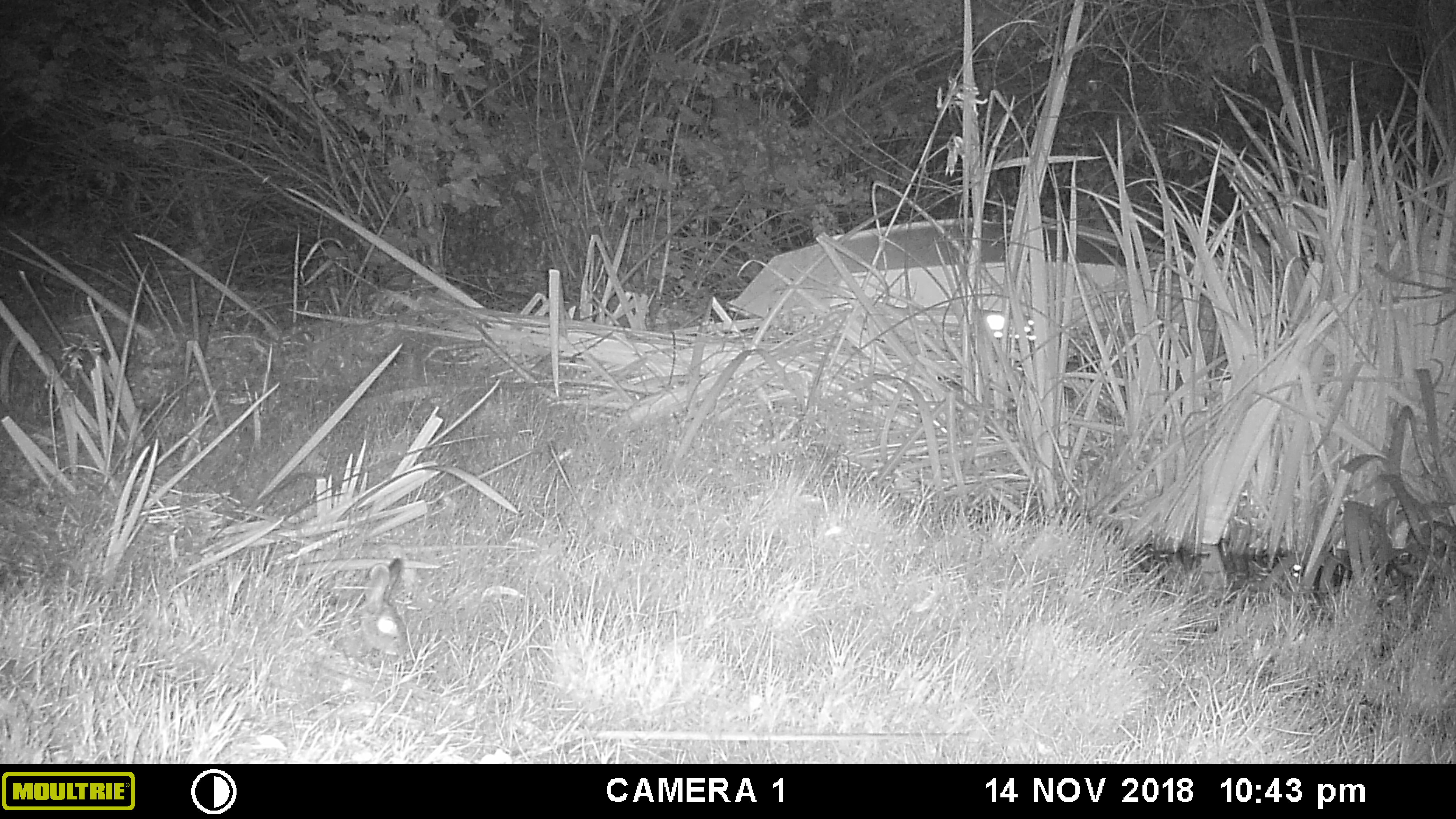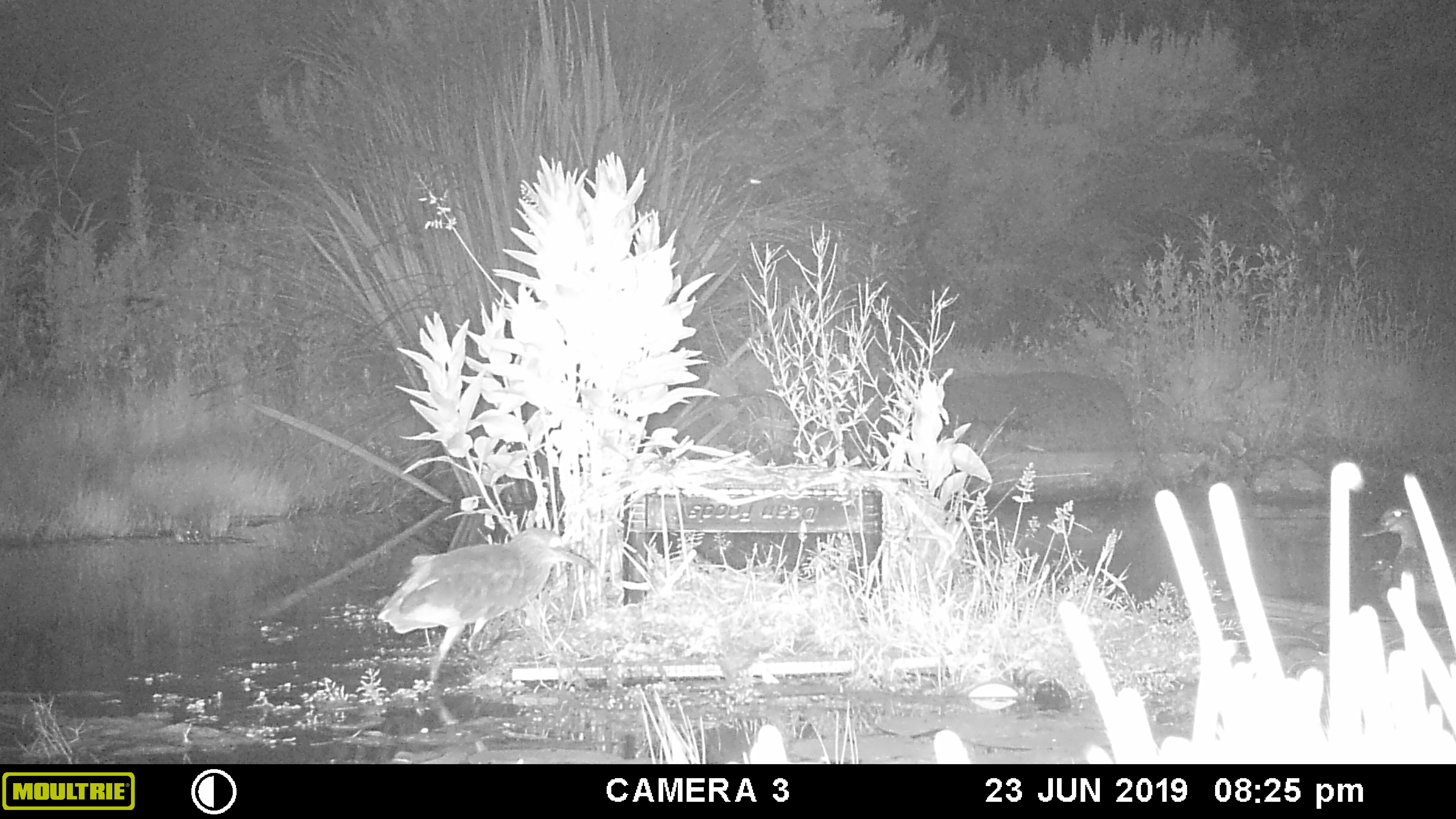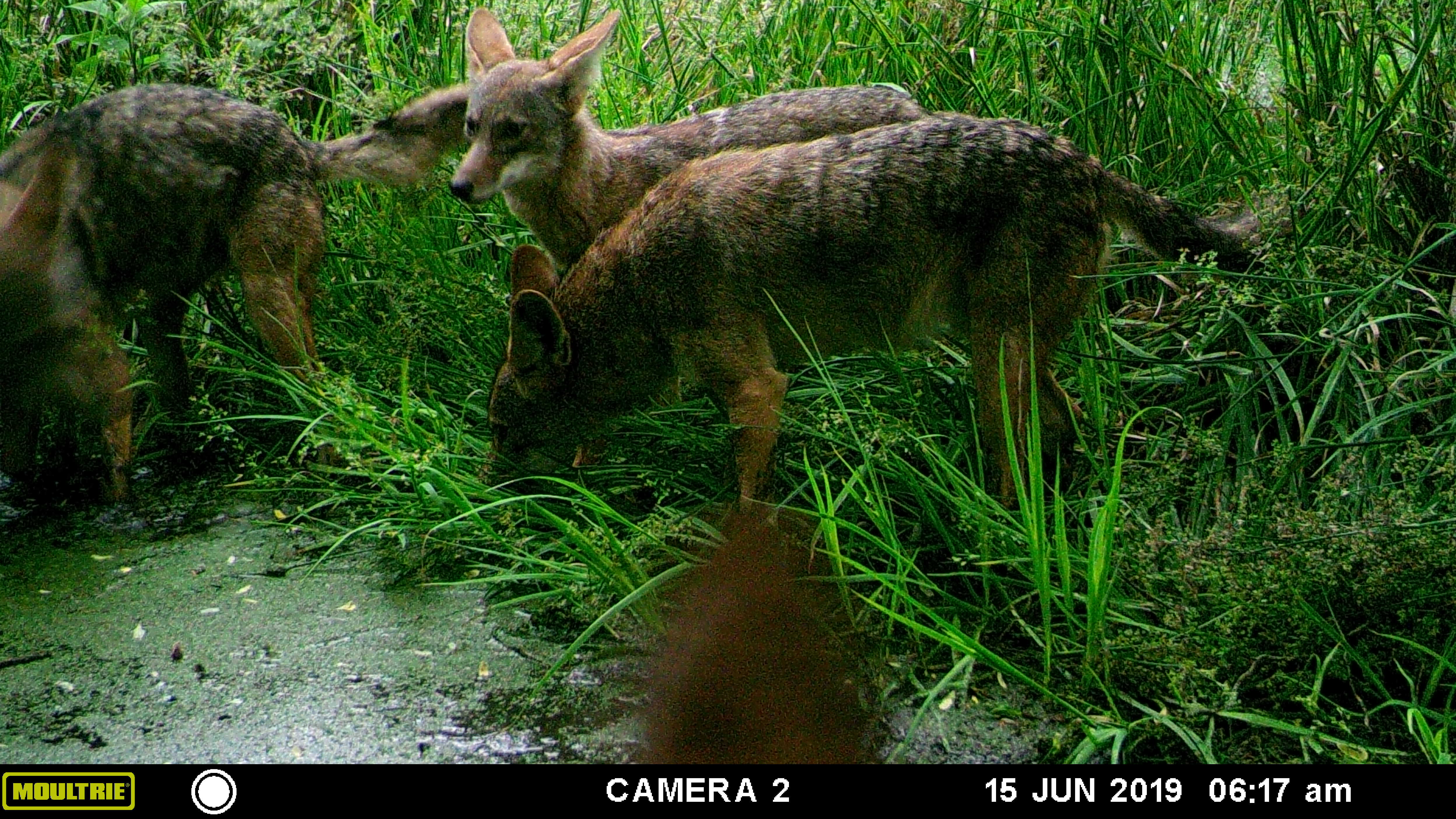-
Aphid Predators II
A WALK ON THE TINY SIDE

Remember this image of a sneaky syrphid fly larvae? Well, what I didn’t point out before was that there’s an even sneakier attendee at this aphid-nomming party. And she’s that little black line across the white leaf vein in the top middle of the photo: a parasitoid wasp.
Parasitoid wasps are pretty full-on — their simple life functions can include grotesqueries you thought only originated in the imaginations of sci-fi script writers. But they’re part of the complex web of ecological checks and balances in their systems.
The difference between parasitic and parasitoid is that a parasitic animal generally doesn’t kill or even directly seriously harm the host; it needs the host to continue functioning so that it can support the parasite. A parasitoid uses the host up in the process of supporting its own growth and/or reproduction.
That sneaky parasitoid lady and her cohort are the authors of the scene of destruction above. What look like little brown bumps on my Brussels sprouts leaf are in fact the corpses of aphids: the dried, hardened exoskeletons of used-up hosts. You can even see a small, round hole in the top of one — the door the exiting parasitoid punched out and left open behind it.
Parasitoid wasps like this one home in on the distinct chemicals released by the feeding and typical drama (like terror over a syrphid fly larva attack) of an aphid colony. Fertilized females settle on leaves and begin their prowl.
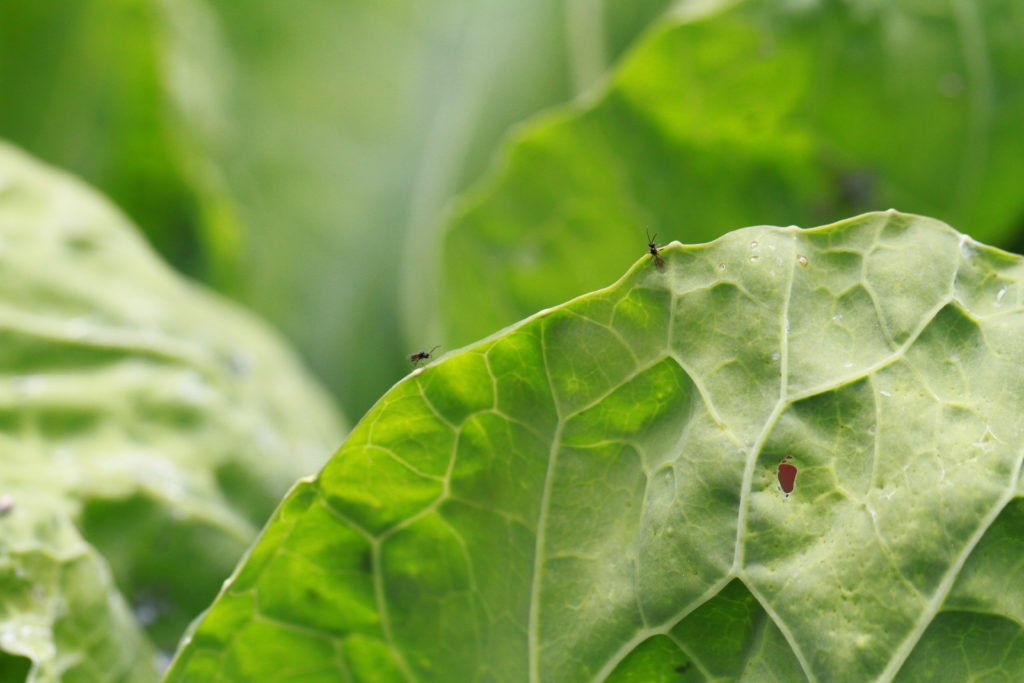
They’re looking for nice, juicy aphids that will be able to feed their grubs to adulthood. With a quick stab of her ovipositor, a female wasp injects a single egg into a chosen aphid, then prowls on. Once that tiny egg hatches, however, the aphid will slowly be hollowed out from the inside by the hungry, growing grub, until only a husk is left and the mature wasp breaks its way out, exercising its brand-new wings in flight for the first time.
The world is made up of opportunities being taken: everything is a resource and every resource is a chance for an existence to bloom. Sometimes, that existence is just really horrific. But it works for them and it works to create a functioning ecosystem — dynamic equilibrium — so we can all actually be very grateful for the parasitoid wasps.
Creeped out, but grateful. -
Aphid Predators
A WALK ON THE TINY SIDE
Another blooming colony of cabbage aphids (Brevicoryne brassicae) on my brave Brussels sprouts: a familiar sight, especially as the weather warms.
But wait — what’s that?
That! The green thing!

It may look a lot like a cabbage white butterfly (Pieris rapae) caterpillar, but it’s definitely not. Take a closer look and you’ll see that rather than a mouthful of sprout leaf, this little green guy is munching on aphid.
One of the most numerous, in terms of species, groups of animals on Earth are the flies, order Diptera. Like any large family, there are some gems, some bad apples, some neutrals — and of course, all that depends on your point of view. To aphids, larvae of some Syrphid flies (family Syrphidae) are stone cold bad-‘uns.
Also known as ‘flower flies’ and ‘hover flies’, these natty little fellows pull a lot of weight (each species in its own way) in both natural and altered ecosystems. Their secret is in their adaptable nature: they’re able to take to human-made environments, so are often some of the only native wildlife in housing developments.

The tellingly-named four–spotted aphid fly, Dioprosopa clavata. Most species in North America as adults mimic bees with yellow, black and striped uniforms and certainly rival and even surpass native bees in pollination services (bees are generally more sensitive in many ways and so are more often excluded or eliminated from habitats). They eat nectar and pollen, as bees do, thus the common name ‘flower fly’.

Flies’ eyes are very distinctive and always give away dipterid mimics passing as other insects — you can’t hide those flyin’ eyes, Copestylum avidum! And of course, most syrphid fly larvae are voracious predators of aphids, making them powerful elements of any garden’s pest management system (a.k.a. ecosystem). Be sure to make friends with yours! Get in touch with Pest Control Cincinnati

- Animals, Bees, Birding, Chickens, Gardening adventures, Natives, Other Insects, Permaculture and Edible Forest Gardening Adventures, Ponds, Rain Catching, Recycling and Repurposing, Reptiles and Amphibians, Soil, Water, Water Saving
Rebuilding Our Habitat Pond… Again
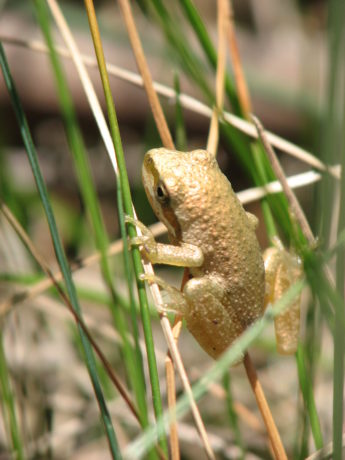 Here in Fallbrook, CA, in San Diego’s north county, we’ve had 3 1/2 inches of rain in the past eleven months, and that came overnight several weeks ago. Last year we had a historic 20+ inches of rain which no one was prepared for, as our average is now about eight to ten inches. This year, the plants and animals are in trouble already. The days are hot and dry, with no rain in the forecast for our three rainiest months. I’ve heard people say that they never recommend a pond in a drought, but they can’t be more wrong ecologically speaking. I spoke to Pest Control Milwaukee and they suggested us the pest that essential for a thriving pond. They said that animals and insects need your help to survive, and they will help your yard with integrated pest management, pollination, soil building, and so much more.
Here in Fallbrook, CA, in San Diego’s north county, we’ve had 3 1/2 inches of rain in the past eleven months, and that came overnight several weeks ago. Last year we had a historic 20+ inches of rain which no one was prepared for, as our average is now about eight to ten inches. This year, the plants and animals are in trouble already. The days are hot and dry, with no rain in the forecast for our three rainiest months. I’ve heard people say that they never recommend a pond in a drought, but they can’t be more wrong ecologically speaking. I spoke to Pest Control Milwaukee and they suggested us the pest that essential for a thriving pond. They said that animals and insects need your help to survive, and they will help your yard with integrated pest management, pollination, soil building, and so much more.Many years ago my daughter and I tore out this big juniper in front of our dining room window and dug a pond. I received a used pond liner, flagstone and some rocks for free from a source that didn’t want them. For years I had a lined pond, and I reconfigured it and the flagstones three times over the years. I’ve built new muscles lifting and hauling large, thick pieces of flagstones. With the success of our large unlined pond (blessed with thick clay at the bottom of the property) I wanted to make this little one unlined as well. The benefits would be that I could grow water plants in-ground, and better aquatic creatures could thrive in it. The problem was that up top by the house there is a lot of decomposed granite, which is porous. So I spent many a day digging up clay from various areas on the property, pushing the buckets or wheelbarrow uphill through mulch, lugging it over and lining the pond with it. Miranda hauled clay as well. Six inches of clay still didn’t seal it. I’d been refilling the pond every few days with well water, but the level would change dramatically and the Pacific Chorus Frogs
 that used to come to the pond in great numbers, sing deafeningly in January and February, lay eggs and then go off to eat more bugs in the yard, weren’t coming anymore. The low pond water allowed watercress and other plants to fill it up as well. Now it is frog breeding time, and there is little habitat for them.
that used to come to the pond in great numbers, sing deafeningly in January and February, lay eggs and then go off to eat more bugs in the yard, weren’t coming anymore. The low pond water allowed watercress and other plants to fill it up as well. Now it is frog breeding time, and there is little habitat for them.So a few weeks ago I purchased new pond liner. My daughter and I pulled the pond apart, fed the watercress to the hens,

dug up clay and hauled it back down the hill (used it in raised beds) (best traveled clay anywhere),
 reshaped and enlarged the pond giving it plenty of edges, cushioned it with newspaper,
reshaped and enlarged the pond giving it plenty of edges, cushioned it with newspaper, 
relined it,
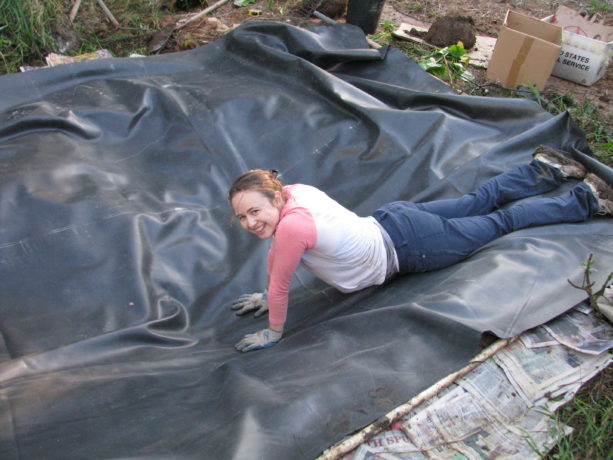 moved around the flagstones yet again, transplanted a water lily from the big pond below into a sunken pot,
moved around the flagstones yet again, transplanted a water lily from the big pond below into a sunken pot,  transplanted creeping red fescue and a few green lilies around the edges, and installed a circulation pump which allows water to flow through a bird bath. We were finishing the work today, on this balmy, dry, 85F February 1, when Miranda noticed frog spawn attached to floating pine needles.
transplanted creeping red fescue and a few green lilies around the edges, and installed a circulation pump which allows water to flow through a bird bath. We were finishing the work today, on this balmy, dry, 85F February 1, when Miranda noticed frog spawn attached to floating pine needles.
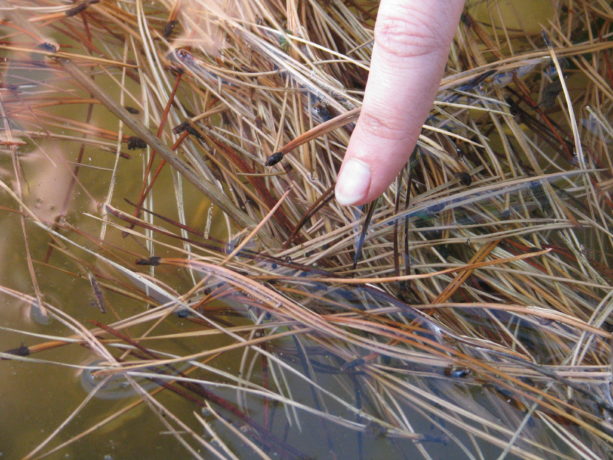 Over the last week while the pond had been full, the magic had already worked! So she corralled the pine needles – fallen from a newly deceased huge beautiful pine in our driveway that died because the neighbor randomly cut its roots in the heat of summer – into the shallow end to keep the spawn safe. Miranda cut some floppy dwarf cattail stems and stuck them into the submerged water lily pot so the frogs could attach their spawn to something stationery.
Over the last week while the pond had been full, the magic had already worked! So she corralled the pine needles – fallen from a newly deceased huge beautiful pine in our driveway that died because the neighbor randomly cut its roots in the heat of summer – into the shallow end to keep the spawn safe. Miranda cut some floppy dwarf cattail stems and stuck them into the submerged water lily pot so the frogs could attach their spawn to something stationery.  We’d overlapped the edges with flagstone so there were plenty of sneaky places for frogs to hide out. We also have edges of different depths, for different sized birds such as the white crown sparrow below to bathe in, and they have been enjoying these areas immensely. We should charge a dirty bird spa fee!
We’d overlapped the edges with flagstone so there were plenty of sneaky places for frogs to hide out. We also have edges of different depths, for different sized birds such as the white crown sparrow below to bathe in, and they have been enjoying these areas immensely. We should charge a dirty bird spa fee!
Within half an hour of us finishing outside, while we ate a very late lunch, we had many diverse avian visitors coming in for a drink. The sound of water carries very far and will attract birds better than food sources. Even a female phainopepla, one of our few crested birds, enjoyed the new running water source.

Followed by a mockingbird,

this wonderful thrush

a scrub jay

and more. Pond visitors today were also house finches, bushtits, a pair of mourning doves, bluebirds, crows, Western bluebirds, Anna’s hummingbirds, a tanager, Lincoln sparrow, and more.
Then when the sun was about to set, the male Pacific chorus frogs gave out a practice singing session, just to see who was in the game for after it got dark.
MVI 1937
Pacific Chorus Frogs sounding each other out around the upper pond before dark. Its breeding season!
You can make a small pond in a cattle waterer or other metal container, or suspend a big soda bottle over a concave dish and pierce a small hole in the bottom so that it very slowly drips. Provide some shelter for the animals around your watering hole, and you’ll be helping the wildlife get through these extremely dry days. They will respond by eating your bad bugs, building soil, pollinating and so much more.
 Be sure to watch the action, through a window or via a wildlife camera! Its better than TV, and no commercials.
Be sure to watch the action, through a window or via a wildlife camera! Its better than TV, and no commercials.
(Photos Diane and Miranda Kennedy)
